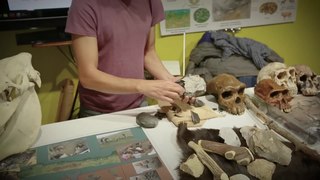 Cover of the first issue | |
| Author | Gary Frank |
|---|---|
| Genre | comics |
| Publisher | Top Cow |
Kin is a six-issue comic-book limited series created in 2000 by Gary Frank and published by Top Cow, an imprint of American company Image Comics.
 Cover of the first issue | |
| Author | Gary Frank |
|---|---|
| Genre | comics |
| Publisher | Top Cow |
Kin is a six-issue comic-book limited series created in 2000 by Gary Frank and published by Top Cow, an imprint of American company Image Comics.
A secret government agency S.I.A. finds out that the neanderthals still exist hidden in Alaskan mountains and proceed to eliminate them in order to obtain their technology that developed differently from the rest of the world. A S.I.A. agent Trey McAloon confronts the organization about the issue while Alaskan Park Ranger Elizabeth Leaky establishes contact with one member of the neanderthals.
The mini-series had an open-ended final, with questions of another S.I.A. boss whose orders formed the operation unanswered as well as the fate of a tribe of neanderthals that were shifted to another S.I.A. base.
The series was collected in a trade paperback collection form subtitled "Descent of Man" with 6 new pages of story and art. It was also translated and published in France, Mexico and Brazil.

Svante Pääbo is a Swedish geneticist and Nobel Laureate who specialises in the field of evolutionary genetics. As one of the founders of paleogenetics, he has worked extensively on the Neanderthal genome. In 1997, he became founding director of the Department of Genetics at the Max Planck Institute for Evolutionary Anthropology in Leipzig, Germany. Since 1999, he has been an honorary professor at Leipzig University; he currently teaches molecular evolutionary biology at the university. He is also an adjunct professor at Okinawa Institute of Science and Technology, Japan.
Who Goes There? is a 1938 science fiction horror novella by American author John W. Campbell, written under the pen name Don A. Stuart. Its story follows a group of people trapped in a scientific outpost in Antarctica infested by shapeshifting monsters able to absorb and perfectly imitate any living being, including humans. Who Goes There? was first published in the August 1938 issue of Astounding Science Fiction magazine and was also printed as The Thing from Another World, as well as included in the collection by the same title. Its extended, novel version, found in an early manuscript titled Frozen Hell, was finally published in 2019.

"The Ugly Little Boy" is a science fiction short story by American writer Isaac Asimov. The story first appeared in the September 1958 issue of Galaxy Science Fiction under the title "Lastborn", and was reprinted under its current title in the 1959 collection Nine Tomorrows. The story deals with a Homo neanderthalensis child which is brought to the future by means of time travel. Robert Silverberg later expanded it into a novel with the same title published in 1992.

Alaska Natives are the Indigenous peoples of Alaska and include Alaskan Creoles, Iñupiat, Yupik, Aleut, Eyak, Tlingit, Haida, Tsimshian, and a number of Northern Athabaskan cultures. They are often defined by their language groups. Many Alaska Natives are enrolled in federally recognized Alaska Native tribal entities, who in turn belong to 13 Alaska Native Regional Corporations, who administer land and financial claims.

Gary Frank is a British comics artist, notable for pencilling on Midnight Nation and Supreme Power, both written by J. Michael Straczynski. He has also worked with author Peter David on The Incredible Hulk and Supergirl. He had a creator-owned series, Kin, which he wrote himself, published by Top Cow Productions in 2000.

In the archaeology of the Stone Age, an industry or technocomplex is a typological classification of stone tools.
A Chinese kin, lineage or sometimes rendered as clan, is a patrilineal and patrilocal group of related Chinese people with a common surname sharing a common ancestor and, in many cases, an ancestral home.

Sia Kate Isobelle Furler is an Australian singer and songwriter. Born and raised in Adelaide, she started her career as a singer in the acid jazz band Crisp in the mid-1990s. When Crisp disbanded in 1997, she released her debut studio album, OnlySee, in Australia. Sia moved to London and provided vocals for the British duo Zero 7. She released her second studio album, Healing Is Difficult, in 2001 and her third, Colour the Small One, in 2004.
The Neanderthal Parallax is a trilogy of novels written by Robert J. Sawyer and published by Tor. It depicts the effects of the opening of a connection between two versions of Earth in different parallel universes: the world familiar to the reader, and another where Neanderthals became the dominant intelligent hominid. The societal, spiritual and technological differences between the two worlds form the focus of the story.

The Divje Babe flute, also called tidldibab, is a cave bear femur pierced by spaced holes that was unearthed in 1995 during systematic archaeological excavations led by the Institute of Archaeology of the Research Centre of the Slovenian Academy of Sciences and Arts, at the Divje Babe I near Cerkno in northwestern Slovenia. It has been suggested that it was made by Neanderthals as a form of musical instrument, and became known as the Neanderthal flute. The artifact is on prominent public display in the National Museum of Slovenia in Ljubljana as a Neanderthal flute. As such, it would be the world's oldest known musical instrument.

Dance of the Tiger is a novel by Finnish palaeontologist Björn Kurtén, published in 1978 and English translation in 1980. It is a prehistoric novel dealing with the interaction between Neanderthals and Cro-Magnons. A sequel, Singletusk, published in 1982, continues the story of the family.

Valley of the Dinosaurs is an American animated television series produced by the Australian studios of Hanna-Barbera Productions and broadcast on CBS from September 7 to December 21, 1974, and in syndication from 1977 to 1983. The series, about a contemporary family sucked by a vortex back to the Stone Age was intended to be educational as well as entertaining, demonstrating the early human uses of fire, clothing, weapons and cooking. It debuted on the same day as Land of the Lost.
The Neanderthal genome project is an effort of a group of scientists to sequence the Neanderthal genome, founded in July 2006.

Korg: 70,000 B.C. is a 30-minute Saturday morning live-action television series created by Fred Freiberger and produced by Hanna-Barbera Productions; it was broadcast on ABC from September 7, 1974, to August 30, 1975.

Teshik-Tash 1 is a Neanderthal skeleton discovered in 1938 in Teshik-Tash Cave, in the Bajsuntau mountain range, Uzbek SSR (Uzbekistan), Central Asia.

The Society for Industrial Archeology (SIA) is a North American nonprofit organization dedicated to studying and preserving historic industrial sites, structures and equipment. It was founded in 1971 in Washington, D.C., and its members are primarily from the United States and Canada, although there is some crossover with similar industrial archaeology organizations in the United Kingdom. SIA's headquarters is currently located in the Department of Social Sciences at Michigan Technological University in Houghton, Michigan. In addition to the national organization, there are thirteen regional chapters throughout the United States.
Lion.Hearts (谈谈情,舞舞狮) is the eleventh international co-production of MediaCorp TV and ntv7. It is a Chinese New Year themed drama which follows the life of young lion dancers. The romantic comedy boasts fast-paced action in the form of traditional Chinese lion dance.

Savage Wolverine was an ongoing comic book series published by Marvel Comics and starring Wolverine. The series began in January 2013 as part of Marvel's relaunch initiative, Marvel NOW!. The series ended after 23 issues.
The Obi-Rakhmat Grotto is a Middle Paleolithic prehistoric site that yielded Neanderthal fossils. It is a shallow karst cave near the junction of the Chatkal and Pskem Rivers at the southwestern end of the Talassky Alatau Range in the Tien Shan Mountains, 100 km (62 mi) northeast of Tashkent, Uzbekistan.

Trou de l’Abîme also known as La caverne de l'Abîme and Couvin Cave is a karst cave located in Wallonia on the right bank of the Eau Noire river in the center of Couvin, Belgium, in Namur province. During various archaeological excavations of sediment deposits, Mousterian artefacts and a Neanderthal molar were discovered.